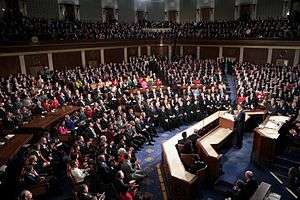Article Two of the United States Constitution
| Wikisource has original text related to this article: |
| This article is part of a series on the |
| Constitution of the United States of America |
|---|
 |
|
Preamble and Articles of the Constitution |
| Amendments to the Constitution |
|
|
| Unratified Amendments |
| History |
| Full text of the Constitution and Amendments |
|
Article Two of the United States Constitution establishes the executive branch of the federal government, which carries out and enforces federal laws. It includes the President, the Vice President, the Cabinet, executive departments, independent agencies, and other boards, commissions, and committees.
Section 1: President and Vice President
Clause 1: Executive Power
The executive Power shall be vested in a President of the United States of America. He shall hold his Office during the Term of four Years, and, together with the Vice President, chosen for the same Term, be elected, as follows[1]
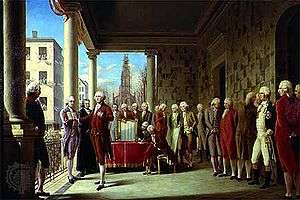
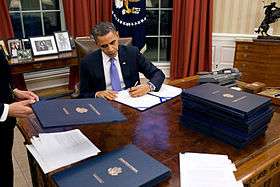
Section 1 begins with a vesting clause that confers federal executive power upon the President (the executive branch). Similar clauses are found in Article I and Article III. The former bestows federal legislative power exclusively to Congress (the legislative branch), and the latter grants judicial power solely to the Supreme Court (the judicial branch). These three articles create a separation of powers among the three branches of the federal government.
In addition to separation of powers and equally important to limited government, each independent and sovereign branch also provides checks and balances on the operation and power of the other two branches.
The President's executive power is subject to two important limitations. First, the President lacks executive authority explicitly granted to Congress. Hence the President cannot declare war, grant letters of marque and reprisal, or regulate commerce, even though executives had often wielded such authority in the past. In these instances, Congress retained portions of the executive power that the Continental Congress had wielded under the Articles of Confederation.
In fact, because those actions require legislation passed by Congress which must be signed by the President to take effect, those powers are not strictly executive powers granted to or retained by Congress per se. Nor were they retained by the U.S. Congress as leftovers from the Articles of Confederation. The Articles of Confederation, Continental Congress and its powers were abolished at the time the new U.S. Congress was seated and the new federal government formally and officially replaced its interim predecessor. And although the President is not specifically granted the power to declare war, a declaration of war is not in and of itself a vehicle of executive power since it is literally just a public declaration that the U.S. government considers itself "at war" with a foreign political entity.
Regardless of the inability to declare war, the President does have the power to unilaterally order military action in defense of the United States when he determines that a foreign political entity poses a clear and present danger to the safety and security of the United States. By U.S. law, the only limitation on that power is a requirement to notify specific members of Congress within 48 hours after the beginning of military operations. Once proper legal notification is given to the required members of Congress, military action can continue and remain secret so long as the President judges it necessary to national security.
Second, specific constitutional provisions may check customary executive authority. Notwithstanding his executive power, the President cannot make treaties or appointments without the advice and consent of the Senate. Likewise, the President's pardon power is limited to offenses against the United States (federal crimes) and does not extend to impeachments or violations of state law.[2] As treaties are by U.S. law official agreements with foreign governments recognized as such only after Senate ratification, the President obviously cannot make treaties unilaterally. However, the President does determine and decide U.S. foreign policy and can enter into non-binding discussions and give conditional approval to agreements reached with foreign governments subject to Senate ratification at a future date.
Additionally, since official treaties are specifically created under and by constitutional U.S. law and are entered into by both government and the people as a whole, in his capacity as head of state and as the single individual representative of the United States and its citizens, the President does have Coauthority and Constitutional duty to unilaterally withdraw the United States from treaties if he determines the best interests and well being of the U.S. and its citizens are benefited by doing so.
As far as presidential appointments, as with treaties a person is not officially and legally appointed to a position until their appointment is approved by the Senate. Prior to Senate approval and publication of that approval along with an official date and time for their swearing-in and assumption of duties and responsibilities, they are nominees rather than appointees. And again, the President nominates people for specific positions at his pleasure and can do so without or in spite of Senate advice. Senate consent occurs when a supermajority of senators votes to approve and therefore appoint a nominee.
The head of the Executive Branch is the President. Although also named in this first clause, the Vice President is not constitutionally vested with any executive power. Nonetheless, the Constitution dictates that the President and Vice President are to be elected at the same time, for the same term, and by the same constituency. The framers' intent was to preserve the independence of the executive branch should the person who was Vice President succeed to the duties of the presidency.
Clause 2: Method of choosing electors
Each State shall appoint, in such Manner as the Legislature thereof may direct, a Number of Electors, equal to the whole Number of Senators and Representatives to which the State may be entitled in the Congress: but no Senator or Representative, or Person holding an Office of Trust or Profit under the United States, shall be appointed an Elector.
Under the U.S. Constitution the President and Vice President are chosen by Electors, under a constitutional grant of authority delegated to the legislatures of the several states and the District of Columbia. The Constitution reserves the choice of the precise manner for creating Electors to the will of the state legislatures. It does not define or delimit what process a state legislature may use to create its state college of Electors. In practice, the state legislatures have generally chosen to create Electors through an indirect popular vote, since the 1820s.
In an indirect popular vote, it is the names of the electors who are on the ballot to be elected. Typically, their names are aligned under the name of the candidate for President and Vice President, that they, the Elector, have pledged they will support. It is fully understood by the voters and the Electors themselves that they are the representative "stand-ins" for the individuals to whom they have pledged to cast their electoral college ballots to be President and Vice President. In some states, in past years, this pledge was informal, and Electors could still legally cast their electoral ballot for whomever they chose. More recently, state legislatures have mandated in law that Electors shall cast their electoral college ballot for the Presidential Candidate to whom they are pledged. The constitutionality of such mandates is uncertain.
Each state chooses as many Electors as it has Representatives and Senators representing it in Congress. Under the Twenty-third Amendment, the District of Columbia may choose no more electors than the state with the lowest number of electoral votes. No Senators, Representatives or federal officers may become Electors.
Clause 3: Electors
The Electors shall meet in their respective States, and vote by Ballot for two Persons, of whom one at least shall not be an Inhabitant of the same State with themselves. And they shall make a List of all the Persons voted for, and of the Number of Votes for each; which List they shall sign and certify, and transmit sealed to the Seat of the Government of the United States, directed to the President of the Senate. The President of the Senate shall, in the Presence of the Senate and House of Representatives, open all the Certificates, and the Votes shall then be counted. The Person having the greatest Number of Votes shall be the President, if such Number be a Majority of the whole Number of Electors appointed; and if there be more than one who have such Majority, and have an equal Number of Votes, then the House of Representatives shall immediately chuse [sic] by Ballot one of them for President; and if no Person have a Majority, then from the five highest on the List the said House shall in like Manner chuse [sic] the President. But in chusing [sic] the President, the Votes shall be taken by States, the Representation from each State having one Vote; A quorum for this Purpose shall consist of a Member or Members from two thirds of the States, and a Majority of all the States shall be necessary to a Choice. In every Case, after the Choice of the President, the Person having the greatest Number of Votes of the Electors shall be the Vice President. But if there should remain two or more who have equal Votes, the Senate shall chuse [sic] from them by Ballot the Vice President.
(Note: This procedure was changed by the Twelfth Amendment in 1804.)
In modern practice, each state chooses its electors in popular elections. Once chosen, the electors meet in their respective states to cast ballots for the President and Vice President. Originally, each elector cast two votes for President; at least one of the individuals voted for had to be from a state different from the elector's. The individual with the majority of votes became President, and the runner-up became Vice President. In case of a tie, the House of Representatives could choose one of the tied candidates; if no person received a majority, then the House could again choose one of the five with the greatest number of votes. When the House voted, each state delegation cast one vote, and the vote of a majority of states was necessary to choose a President. If second-place candidates were tied, then the Senate broke the tie. A quorum of two-thirds applied in both Houses: at least one member from each of two-thirds of the states in the House of Representatives, and at least two-thirds of the Senators in the Senate. This procedure was followed in 1801 after the electoral vote produced a tie, and nearly resulted in a deadlock in the House.
The Twelfth Amendment introduced a number of important changes to the procedure. Now, Electors do not cast two votes for President; rather, they cast one vote for President and another for Vice President. In case no Presidential candidate receives a majority, the House chooses from the top three (not five, as with Vice Presidential candidates). The Amendment also requires the Senate to choose the Vice President from those with the two highest figures if no Vice Presidential candidate receives a majority of electoral votes (rather than only if there's a tie for second for President). It also stipulates that to be the Vice President, a person must be qualified to be the President.
Clause 4: Election day
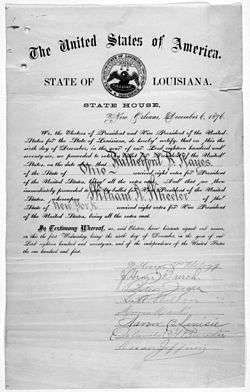
The Congress may determine the Time of chusing [sic] the Electors, and the Day on which they shall give their Votes; which Day shall be the same throughout the United States.
Congress sets a national Election Day. Currently, Electors are chosen on the Tuesday following the first Monday in November, in the year before the President's term is to expire. The Electors cast their votes on the Monday following the second Wednesday in December of that year. Thereafter, the votes are opened and counted by the Vice President, as President of the Senate, in a joint session of Congress.
Clause 5: Qualifications for office
Section 1 of Article Two of the United States Constitution sets forth the eligibility requirements for serving as president of the United States:
No Person except a natural born Citizen, or a Citizen of the United States, at the time of the Adoption of this Constitution, shall be eligible to the Office of President; neither shall any person be eligible to that Office who shall not have attained to the Age of thirty five Years, and been fourteen Years a Resident within the United States.
By the time of their inauguration, the President and Vice President must be:
- natural born citizens
- at least 35 years old
- inhabitants of the United States for at least fourteen years.
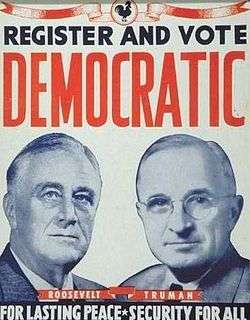
Eligibility for holding the office of President and Vice-President were modified by subsequent amendments:
- The Twelfth Amendment (1804) requires the Vice-President to meet all of the qualifications of being President.
- The Twenty-second Amendment (1951) prevents a President from being elected more than twice
Clause 6: Vacancy and disability
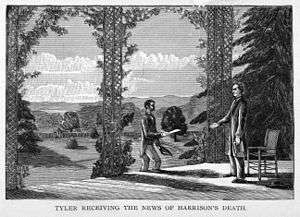
In Case of the Removal of the President from Office, or of his Death, Resignation, or Inability to discharge the Powers and Duties of the said Office, the Same shall devolve on the Vice President, and the Congress may by Law provide for the Case of Removal, Death, Resignation or Inability, both of the President and Vice President, declaring what Officer shall then act as President, and such Officer shall act accordingly, until the Disability be removed, or a President shall be elected.
(Note: This clause was partially superseded by the Twenty-fifth Amendment in 1967.)
The wording of this clause caused much controversy at the time it was first used. When William Henry Harrison died in office, a debate arose over whether the Vice President would become President, or if he would just inherit the powers, thus becoming an Acting President. Harrison's Vice President, John Tyler, believed that he had the right to become President. However, many Senators argued that he only had the right to assume the powers of the presidency long enough to call for a new election. Because the wording of the clause is so vague, it was impossible for either side to prove its point. Tyler took the Oath of Office as President, setting a precedent that made it possible for later Vice Presidents to ascend to the presidency unchallenged following the President's death. The "Tyler Precedent" established that if the President dies, resigns or is removed from office, the Vice President becomes President.
The Congress may provide for a line of succession beyond the Vice President. The current Presidential Succession Act establishes the order as the Speaker of the House of Representatives, the President pro tempore of the Senate and then the fifteen Cabinet Secretaries in order of that Department's establishment.
The Twenty-fifth Amendment explicitly states that if the President dies, resigns or is removed from office, the Vice President becomes President, and also establishes a procedure for filling a vacancy in the office of the Vice President. It supersedes the ambiguous wording of this clause.[3] The Amendment further provides that the President, or the Vice President and Cabinet, can declare the President unable to discharge his duties, in which case the Vice President becomes Acting President. If the declaration is done by the Vice President and Cabinet, the Amendment permits the President to take control back, unless the Vice President and Cabinet challenge the President and two-thirds of both Houses vote to sustain the findings of the Vice President and Cabinet. If the declaration is done by the President, he may take control back without risk of being overridden by the Congress.
Clause 7: Salary
The President shall, at stated Times, receive for his Services, a Compensation, which shall neither be increased nor diminished during the Period for which he shall have been elected, and he shall not receive within that Period any other Emolument from the United States, or any of them.
The President's salary, currently $400,000 a year, must remain constant throughout the President's term. The President may not receive other compensation from either the federal or any state government.
Clause 8: Oath or affirmation
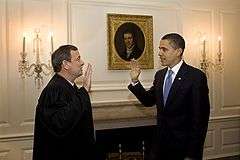
Before he enters the Execution of his Office, he shall take the following Oath or Affirmation:—"I do solemnly swear (or affirm) that I will faithfully execute the Office of President of the United States, and will to the best of my Ability, preserve, protect and defend the Constitution of the United States."
According to the Joint Congressional Committee on Presidential Inaugurations, George Washington added the words "So help me God" during his first inaugural,[4] though this has been disputed. There are no contemporaneous sources for this fact, and no eyewitness sources to Washington's first inaugural mention the phrase at all—including those that transcribed what he said for his oath.
Also, the President-elect's name is typically added after the "I", for example, "I, George Washington, do...." Normally, the Chief Justice of the United States administers the oath. It is sometimes asserted that the oath bestows upon the President the power to do whatever is necessary to "preserve, protect and defend the Constitution." Andrew Jackson, while vetoing an Act for the renewal of the charter of the national bank, implied that the President could refuse to execute statutes that he felt were unconstitutional. In suspending the privilege of the writ of habeas corpus, President Abraham Lincoln claimed that he acted according to the oath. His action was challenged in court and overturned by the U.S. Circuit Court in Maryland (led by Chief Justice Roger B. Taney) in Ex Parte Merryman, 17 F. Cas. 144 (C.C.D. Md. 1861). Lincoln ignored Taney's order. Finally, Andrew Johnson's counsel referred to the theory during his impeachment trial. Otherwise, few have seriously asserted that the oath augments the President's powers.
The Vice President also has an oath of office, but it is not mandated by the Constitution and is prescribed by statute. Currently, the Vice Presidential oath is the same as that for Members of Congress.
- I do solemnly swear (or affirm) that I will support and defend the Constitution of the United States against all enemies, foreign and domestic; that I will bear true faith and allegiance to the same; that I take this obligation freely, without any mental reservation or purpose of evasion; and that I will well and faithfully discharge the duties of the office on which I am about to enter. So help me God.[5]
Section 2: Presidential powers
In the landmark decision Nixon v. General Services Administration Justice William Rehnquist, afterwards the Chief Justice, declared in his dissent the need to "fully describe the preeminent position that the President of the United States occupies with respect to our Republic. Suffice it to say that the President is made the sole repository of the executive powers of the United States, and the powers entrusted to him as well as the duties imposed upon him are indeed a powerful and incredible responsibility but as well as a great honor."
Clause 1: Command of military; Opinions of cabinet secretaries; Pardons
Left to right: General Douglas MacArthur, President Franklin Roosevelt, Admiral William D. Leahy, Admiral Chester W. Nimitz.
The President shall be Commander in Chief of the Army and Navy of the United States, and of the Militia of the several States, when called into the actual Service of the United States; he may require the Opinion, in writing, of the principal Officer in each of the executive Departments, upon any Subject relating to the Duties of their respective Offices, and he shall have Power to grant Reprieves and Pardons for Offenses against the United States, except in Cases of Impeachment.
The Constitution vests the President with Executive Power. That power reaches its zenith when wielded to protect national security.[6] And federal courts in the United States must pay proper deference to the Executive in assessing the threats that face the nation.[7] The President is the military's commander-in-chief; however Article One gives Congress and not the President the exclusive right to declare war. Nevertheless, the power of the president to initiate hostilities has been subject to question. According to historian Thomas Woods, "Ever since the Korean War, Article II, Section 2 [...] has been interpreted 'The president has the power to initiate hostilities without consulting Congress' [....]But what the framers actually meant by that clause was that once war has been declared, it was the President’s responsibility as commander-in-chief to direct the war. Alexander Hamilton spoke in such terms when he said that the president, although lacking the power to declare war, would have “the direction of war when authorized or begun.” The president acting alone was authorized only to repel sudden attacks (hence the decision to withhold from him only the power to “declare” war, not to “make” war, which was thought to be a necessary emergency power in case of foreign attack). [8][9] Since World War II, every major military action has been technically a U.S. military operation or a U.N. "police action", which are deemed legally legitimate by Congress, and various United Nations Resolutions because of decisions such as the Gulf of Tonkin Resolution or the The Resolution of The Congress Providing Authorization for Use of Force In Iraq.
The President may require the "principal officer" of any executive department to tender his advice in writing. While the Constitution nowhere requires a formal Cabinet, it does authorize the president to seek advice from the principal officers of the various departments as he (or she) performs their official duties. George Washington found it prudent to organize his principal officers into a Cabinet, and it has been part of the executive branch structure ever since. Presidents have used Cabinet meetings of selected principal officers but to widely differing extents and for different purposes. Secretary of State William H. Seward and then Professor Woodrow Wilson advocated use of a parliamentary-style Cabinet government. But President Abraham Lincoln rebuffed Seward, and Woodrow Wilson would have none of it in his administration. In recent administrations, cabinets have grown to include including key White House staff in addition to department and agency heads. President Ronald Reagan formed seven subcabinet councils to review many policy issues, and subsequent Presidents have followed that practice.[10]
The President, furthermore, may grant pardon or reprieves, except in cases of impeachment. Originally, as ruled by the Supreme Court in United States v. Wilson (1833), the pardon could be rejected by the convict. In Biddle v. Perovich 274 U.S. 480 (1927), the Supreme Court reversed the doctrine, ruling that "[a] pardon in our days is not a private act of grace from an individual happening to possess power. It is a part of the Constitutional scheme. When granted it is the determination of the ultimate authority that the public welfare will be better served by inflicting less than what the judgment fixed."[11]
Clause 2: Advice and Consent Clause
The President exercises the powers in the Advice and Consent Clause with the advice and consent of the Senate.
He shall have Power, by and with the Advice and Consent of the Senate, to make Treaties, provided two thirds of the Senators present concur; and he shall nominate, and by and with the Advice and Consent of the Senate, shall appoint Ambassadors, other public Ministers and Consuls, Judges of the supreme Court, and all other Officers of the United States, whose Appointments are not herein otherwise provided for, and which shall be established by Law: but the Congress may by Law vest the Appointment of such inferior Officers, as they think proper, in the President alone, in the Courts of Law, or in the Heads of Departments.
Treaties
The President may enter the United States into treaties, but they are not effective until ratified by a two-thirds vote in the Senate.[12] In Article II however, the Constitution is not very explicit about the termination of treaties. The first abrogation of a treaty occurred in 1798, when Congress passed a law terminating a 1778 Treaty of Alliance with France.[13] In the nineteenth century, several Presidents terminated treaties after Congress passed resolutions requesting the same.[14] In 1854, however, President Franklin Pierce terminated a treaty with Denmark with the consent of the Senate alone. A Senate committee ruled that it was correct procedure for the President to terminate treaties after being authorized by the Senate alone, and not the entire Congress. President Pierce's successors, however, returned to the former procedure of obtaining authorization from both Houses. Some Presidents have claimed to themselves the exclusive power of terminating treaties. Abraham Lincoln, for instance, terminated a treaty without prior Congressional authorization, but Congress retroactively approved his decision at a later point. The first unambiguous case of a President terminating a treaty without authorization, granted prior to or after the termination, occurred when Jimmy Carter terminated a treaty with the Republic of China.[15] For the first time, judicial determination was sought, but the effort proved futile: the Supreme Court could not find a majority agreeing on any particular principle, and therefore instructed the trial court to dismiss the case.
Appointments
The President may also appoint judges, ambassadors, consuls, ministers and other officers with the advice and consent of the Senate. By law, however, Congress may allow the President, heads of executive departments, or the courts to appoint inferior officials.
The Senate has a long-standing practice of permitting motions to reconsider previous decisions. In 1931, the Senate granted advice and consent to the President on the appointment of a member of the Federal Power Commission. The officer in question was sworn in, but the Senate, under the guise of a motion to reconsider, rescinded the advice and consent. In the writ of quo warranto proceedings that followed, the Supreme Court ruled that the Senate was not permitted to rescind advice and consent after the officer had been installed.
After the Senate grants advice and consent, however, the President is under no compulsion to commission the officer. It has not been settled whether the President has the prerogative to withhold a commission after having signed it. This issue played a large part in the famous court case Marbury v. Madison.
At times the President has asserted the power to remove individuals from office. Congress has often explicitly limited the President's power to remove; during the Reconstruction Era, Congress passed the Tenure of Office Act, purportedly preventing Andrew Johnson from removing, without the advice and consent of the Senate, anyone appointed with the advice and consent of the Senate. President Johnson ignored the Act, and was later impeached and acquitted. The constitutionality of the Act was not immediately settled. In Myers v. United States, 272 U.S. 52 (1926), the Supreme Court held that Congress could not limit the President's power to remove an executive officer (the Postmaster General), but in Humphrey's Executor v. United States, 295 U.S. 602 (1935) it upheld Congress's authority to restrict the President's power to remove officers of the Federal Trade Commission, an "administrative body [that] cannot in any proper sense be characterized as an arm or eye of the executive."
Congress may repeal the legislation that authorizes the appointment of an executive officer. But it "cannot reserve for itself the power of an officer charged with the execution of the laws except by impeachment."[16] Congress has from time to time changed the number of justices in the Supreme Court.
Clause 3: Recess appointments
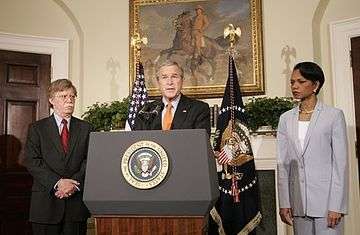
The President shall have Power to fill up all Vacancies that may happen during the Recess of the Senate, by granting Commissions which shall expire at the End of their next Session.
During recesses of the Senate, the President may appoint officers, but their commissions expire at the conclusion of the Senate's next session.
Section 3: Presidential responsibilities
He shall from time to time give to the Congress Information of the State of the Union, and recommend to their Consideration such Measures as he shall judge necessary and expedient; he may, on extraordinary Occasions, convene both Houses, or either of them, and in Case of Disagreement between them, with Respect to the Time of Adjournment, he may adjourn them to such Time as he shall think proper; he shall receive Ambassadors and other public Ministers; he shall take Care that the Laws be faithfully executed, and shall Commission all the Officers of the United States.
Clause 1: State of the Union
The President must give the Congress information on the "State of the Union" "from time to time." This is called the State of the Union Clause.[17] Originally, Presidents personally delivered annual addresses to Congress. Thomas Jefferson, who felt that the procedure resembled the Speech from the Throne delivered by British monarchs, chose instead to send written messages to Congress for reading by clerks. Jefferson's procedure was followed by future Presidents until Woodrow Wilson reverted to the former procedure of personally addressing Congress, which has continued to this day.[17]
Kesavan and Sidak explain the purpose of the State of the Union clause:
- "The State of the Union Clause imposes an executive duty on the President. That duty must be discharged periodically. The President's assessment of the State of the Union must be publicized to Congress, and thus to the nation. The publication of the President's assessment conveys information to Congress- information uniquely gleaned from the President's perspective in his various roles as Commander-in-Chief, chief law enforcer, negotiator with foreign powers, and the like-that shall aid the legislature in public deliberation on matters that may justify the enactment of legislation because of their national importance."[17]
Clause 2: Making recommendations to Congress
The president has the power and duty[17] to recommend, for the consideration of Congress, such measures which the president deems as "necessary and expedient". At his inauguration George Washington declared in his Inaugural Address: "By the article establishing the executive department it is made the duty of the President 'to recommend to your consideration such measures as he shall judge necessary and expedient.'" This is the Recommendation Clause.[18]
Kesavan and Sidak explain the purpose of the Recommendation clause:
- "The Recommendation Clause also imposes an executive duty on the President. His recommendations respect the equal dignity of Congress and thus embody the anti-royalty sentiment that ignited the American Revolution and subsequently stripped the trappings of monarchy away from the new chief executive. Through his recommendations to Congress, the President speaks collectively for the People as they petition Government for a redress of grievances, and thus his recommendations embody popular sovereignty. The President tailors his recommendations so that their natural implication is the enactment of new legislation, rather than some other action that Congress might undertake. Finally, the President shall have executive discretion to recommend measures of his choosing."[17]
Sidak explained that there is a connection between the Recommendation clause and the Petition Clause of the first amendment: "Through his performance of the duty to recommend measures to Congress, the President functions as the agent of a diffuse electorate who seek the redress of grievances. To muzzle the President, therefore, is to diminish the effectiveness of this right expressly reserved to the people under the first amendment."[18]:2119, note 7 Kesavan and Sidak also cited a Professor Bybee who stated in this context: "The Recommendation Clause empowers the President to represent the people before Congress, by recommending measures for the reform of government, for the general welfare, or for the redress of grievances. The Right of Petition Clause prevents Congress from abridging the right of the people to petition for a redress of grievances."[17]:43
The Recommendation clause imposes a duty, but its performance rests solely with the President. Congress possesses no power to compel the President to recommend, as he alone is the "judge" of what is "necessary and expedient." Unlike the Necessary and Proper Clause of Article I, which limits Congress's discretion to carrying out only its delegated powers, the phrase "necessary and expedient" implies a wider range of discretion for the President. Because this is a political question, there has been little judicial involvement with the President's actions under the clause as long as Presidents have not tried to extend their legislative powers. In Youngstown Sheet & Tube Co. v. Sawyer (1952), the Supreme Court noted that the Recommendations Clause serves as a reminder that the President cannot make law by himself: "The power to recommend legislation, granted to the President, serves only to emphasize that it is his function to recommend and that it is the function of the Congress to legislate."[19] The Court made a similar point in striking down the line-item veto in Clinton v. City of New York (1998).[19] When President Bill Clinton attempted to shield the records of the President's Task Force on Health Care Reform as essential to his functions under the Recommendations Clause, a federal circuit court rejected the argument and noted in Ass'n of American Physicians & Surgeons v. Clinton (1993): "[T]he Recommendation Clause is less an obligation than a right. The President has the undisputed authority to recommend legislation, but he need not exercise that authority with respect to any particular subject or, for that matter, any subject."[19]
Clause 3: Calling Congress into extraordinary session; adjourning Congress
To allow the government to act quickly in case of a major domestic or international crisis arising when Congress is not in session, the President is permitted to call extraordinary sessions of one or both Houses of Congress. If the two Houses cannot agree on a date for adjournment, the President may adjourn both Houses to such a time as befits the circumstances. The last time this power was exercised was in 1948, when President Harry S Truman called a special session of Congress. That was the twenty-seventh time in American history that a president convened such a session.[20]
Following the widespread adoption of transcontinental air travel in the second half of the twentieth century, Congress began meeting year-round. Since that time, it has always been in session on every occasion when the President might otherwise have perceived the need to call Congress into extraordinary session.
Clause 4: Receiving foreign representatives
The President receives all foreign Ambassadors. This clause of the Constitution, known as the Reception Clause, has been interpreted to imply that the President can be granted broad power over all matters of foreign policy by Congress,[21] and to provide support for the President's exclusive authority to grant recognition to a foreign sovereign.[22]
Clause 5: Caring for the faithful execution of the law
The President must "take care that the laws be faithfully executed."[23] This clause in the Constitution imposes a duty on the President to take due care while executing laws and is called the Take Care Clause,[24] also known as the Faithful Execution Clause[25] or Faithfully Executed Clause.[26] This clause is meant to ensure that a law is faithfully executed by the President,[24] even if he disagrees with the purpose of that law.[27] By virtue of his executive power, the President may execute the law and control the law execution of others. Under the Take Care Clause, however, the President must exercise his law-execution power to "take Care that the Laws be faithfully executed."[25] Addressing the North Carolina ratifying convention, William Maclaine declared that the Faithful Execution Clause was "one of the [Constitution's] best provisions."[25] If the President "takes care to see the laws faithfully executed, it will be more than is done in any government on the continent; for I will venture to say that our government, and those of the other states, are, with respect to the execution of the laws, in many respects mere ciphers."[25] President George Washington interpreted this clause as imposing on him a unique duty to ensure the execution of federal law. Discussing a tax rebellion, Washington observed, "it is my duty to see the Laws executed: to permit them to be trampled upon with impunity would be repugnant to [that duty.]"[25]
According to former United States Assistant Attorney General Walter E. Dellinger III, the Supreme Court and the Attorneys General have long interpreted the Take Care Clause to mean that the President has no inherent constitutional authority to suspend the enforcement of the laws, particularly of statutes.[28] The Take Care Clause demands that the President obey the law, the Supreme Court said in Humphrey's Executor v. United States, and repudiates any notion that he may dispense with the law's execution.[29] In Printz v. United States, 521 U.S. 898 (1997), the Supreme Court explained how the President executes the law: "The Constitution does not leave to speculation who is to administer the laws enacted by Congress; the President, it says, "shall take Care that the Laws be faithfully executed," Art. II, §3, personally and through officers whom he appoints (save for such inferior officers as Congress may authorize to be appointed by the "Courts of Law" or by "the Heads of Departments" with other presidential appointees), Art. II, §2."
The President may not prevent a member of the executive branch from performing a ministerial duty lawfully imposed upon him by Congress. (See Marbury v. Madison (1803); and Kendall v. United States ex rel. Stokes (1838)). Nor may the President take an action not authorized either by the Constitution or by a lawful statute. (See Youngstown Sheet & Tube Co. v. Sawyer (1952)). Finally, the President may not refuse to enforce a constitutional law, or "cancel" certain appropriations, for that would amount to an extra-constitutional veto or suspension power.[25]
The President, while having to enforce the law, also possesses wide discretion in deciding how and even when to enforce laws. He also has a range of interpretive discretion in deciding the meaning of laws he must execute. When an appropriation provides discretion, the President can gauge when and how appropriated moneys can be spent most efficiently.
Some Presidents have claimed the authority under this clause to impound money appropriated by Congress. President Jefferson, for example, delayed the expenditure of money appropriated for the purchase of gunboats for over a year. President Franklin D. Roosevelt and his successors sometimes refused outright to expend appropriated money.[25] The Supreme Court, however, has held that impoundments without Congressional authorization are unconstitutional.[30]
It has been asserted that the President's responsibility in the "faithful" execution of the laws entitles him to suspend the privilege of the writ of habeas corpus. Article One provides that the privilege may not be suspended save during times of rebellion or invasion, but it does not specify who may suspend the privilege. The Supreme Court ruled that Congress may suspend the privilege if it deems it necessary. During the American Civil War, President Abraham Lincoln suspended the privilege, but, owing to the vehement opposition he faced, obtained congressional authorization for the same. Since then, the privilege of the writ has only been suspended upon the express authorization of Congress.
In Mississippi v. Johnson, 71 U.S. 475 (1867), the Supreme Court ruled that the judiciary may not restrain the President in the execution of laws. In that case the Supreme Court refused to entertain a request for an injunction preventing President Andrew Johnson from executing the Reconstruction Acts, which were claimed to be unconstitutional. The Court found that "[t]he Congress is the legislative department of the government; the President is the executive department. Neither can be restrained in its action by the judicial department; though the acts of both, when performed, are, in proper cases, subject to its cognizance."[31] Thus, the courts cannot bar the passage of a law by Congress, though it may strike down such a law as unconstitutional. A similar construction applies to the executive branch.
Clause 6: Officers' commissions
The President commissions "all the Officers of the United States." These include officers in both military and foreign service. (Under Article I, Section 8, the States have authority for "the Appointment of the Officers . . . of the [State] Militia . . ..")
The presidential authority to commission officers had a large impact on the 1803 case Marbury v. Madison, where outgoing Federalist President John Adams feverishly signed many commissions to the judiciary on his final day in office, hoping to, as incoming Democratic-Republican President Thomas Jefferson put it, "[retire] into the judiciary as a stronghold." However, in his haste, Adams' Secretary of State neglected to have all the commissions delivered. Incoming President Jefferson was enraged with Adams, and ordered his Secretary of State, James Madison, to refrain from delivering the remaining commissions. William Marbury took the matter to the Supreme Court, where the famous Marbury was decided.
Section 4: Impeachment
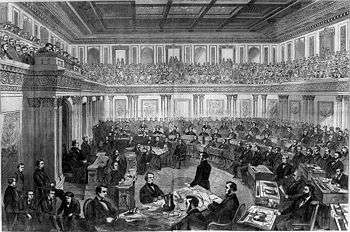
The President, Vice President and all civil Officers of the United States, shall be removed from Office on Impeachment for, and Conviction of, Treason, Bribery, or other High crimes and Misdemeanors.
The Constitution also allows for involuntary removal from office. The President, Vice-President, Cabinet Secretaries, and other executive officers, as well as judges, may be impeached by the House of Representatives and tried in the Senate.
Any official convicted by impeachment is immediately removed from office. The Senate may also choose to bar the removed official from holding any federal office in the future.[32] No other punishments may be inflicted pursuant to the impeachment proceeding, but the convicted party remains liable to trial and punishment in the courts for civil and criminal charges.[33]
References
- ↑ The U.S. Constitution With Declaration of Independence, US Government Printing Office
- ↑ Prakash, Sai Prakash. "Essays on Article II: Executive Vesting Clause". The Heritage Foundation.
- ↑ The Constitution And Democracy
- ↑ "Joint Congressional Committee on Presidential Inaugurations". Retrieved November 10, 2006.
- ↑ 5 U.S.C. § 3331
- ↑ Cf: Youngstown Sheet & Tube Co. v. Sawyer, 343 U.S. 579,637 (1952) (Jackson, J., concurring) ("When the President acts pursuant to an express or implied authorization from Congress," his actions are "supported by the strongest of presumptions and the widest latitude of judicial interpretation, and the burden of persuasion ... rest[s] heavily upon any who might attack it.").
- ↑ Boumediene v. Bush, 553 U.S. 723, 797 (2008) ("[M]ost federal judges [do not] begin the day with briefings that describe new and serious threats to our Nation and its people.").
- ↑ Woods, Thomas (July 7, 2005) Presidential War Powers, LewRockwell.com
- ↑ Woods, Thomas (2013). "Presidential War Powers: The Constitutional Answer". Liberty Classrooom. Retrieved September 6, 2013.
- ↑ Gaziano, Todd. "Essays on Article II: Opinion Clause". The Heritage Foundation.
- ↑ Biddle, at 486
- ↑ United States Senate. "Treaties". senate.gov.
- ↑ United States Library of Congress (February 15, 2011). "Primary Documents in American History Treaty of Alliance with France". loc.gov.
- ↑ John H. Haswell, University of Minnesota; United States Department of State (2010). Treaties and Conventions Concluded Between the United States of America Since July 4, 1776. google.books.com. pp. 1,232.
- ↑ Goldwater v. Carter, 444 U.S. 996 (1979)
- ↑ Bowsher v. Synar, 478 U.S. 714 (1986)
- 1 2 3 4 5 6 Vasan Kesavan and J. Gregory Sidak (2002). "The Legislator-In-Chief". William and Mary Law Review. 44 (1). Retrieved June 28, 2012.
- 1 2 Sidak, Gregory (August 1989). "The Recommendation Clause". Georgetown Law Journal. 77 (6): 2079–2135. Retrieved June 29, 2012.
- 1 2 3 Kesavan, Vasan. "The Heritage Guide to the Constitution: Recommendations Clause". The Heritage Foundation. Retrieved October 27, 2012.
- ↑ U.S. Senate Turnip Day Session (January 5, 2011).
- ↑ United States v. Curtiss-Wright Export Corp., 299 U.S. 304 (1936), characterized the President as the "sole organ of the nation in its external relations," an interpretation criticized by Louis Fisher of the Library of Congress.
- ↑ Zivotofsky v. Kerry, 576 U.S. ___ (2015), slip op. at 8-9.
- ↑ "Article II, Section 3, U.S. Constitution". law.cornell.edu. Legal Information Institute. 2012. Retrieved August 7, 2012.
- 1 2 "Take Care Clause Law & Legal Definition". USLegal.com. Retrieved July 5, 2012.
- 1 2 3 4 5 6 7 Take Care Clause. "Take Care Clause". The Heritage Guide to the Constitution. The Heritage Foundation. Retrieved October 12, 2012.
- ↑ Prepared by Devotion Garner. Updated by Cheryl Nyberg. "Popular Names of Constitutional Provisions". Gallagher Library of the University of Washington School of Law. Retrieved November 23, 2013.
- ↑ "Chapter 12-The Presidency Flashcards". Flashcard Machine. January 16, 2012. Retrieved July 5, 2012.
- ↑ Walter E. Dellinger III (September 7, 1995). "CONSTITUTIONAL LIMITATIONS ON FEDERAL GOVERNMENT PARTICIPATION IN BINDING ARBITRATION". United States Department of Justice. Retrieved July 5, 2012.
- ↑ Kinkopf, Neil (September–October 2005). "FURIOUS GEORGE - The belligerence of the Bush Administration in pursuing expansive power has a long Republican pedigree". Legal Affairs - The magazine at the intersection of Law and Life. Retrieved July 5, 2012.
- ↑ Sai Prakash. "Take Care Clause". The Heritage Guide to the Constitution. The Heritage Foundation. Retrieved August 27, 2012.
- ↑ Johnson, at 500
- ↑ An example of this is Alcee Hastings who was removed from a federal judgeship, but was not barred from serving in another federal office. He was later elected to, and currently serves in, the House of Representatives.
- ↑ Cf. Ritter v. United States, 677 F.2d 957 (2d. Cir. 19) 84 Ct. Cl. 293, 300 (Ct. Cl. 1936) ("While the Senate in one sense acts as a court on the trial of an impeachment, it is essentially a political body and in its actions is influenced by the views of its members on the public welfare."); STAFF OF H. COMM. ON THE JUDICIARY, 93D CONG., CONSTITUTIONAL GROUNDS FOR PRESIDENTIAL IMPEACHMENT 24 (Comm. Print 1974) ("The purpose of impeachment is not personal punishment; its function is primarily to maintain constitutional government.") (citation omitted), reprinted in 3 LEWIS DESCHLER, DESCHLER'S PRECEDENTS OF THE UNITED STATES HOUSE OF REPRESENTATIVES, H.R. DOC. NO. 94‒661 ch. 14, app. at 2269 (1977).
External links
- Kilman, Johnny and George Costello (Eds). (2000). The Constitution of the United States of America: Analysis and Interpretation.
- CRS Annotated Constitution: Article 2
- Mount, Steve. (2003). "Presidential Pardons."
